Make a quantile-quantile plot of two samples
create.qqplot.comparison.RdTakes two samples and creates a qq plot for comparing two distributions, possibly conditioned on other variables
Usage
create.qqplot.comparison(
x,
data = NULL,
filename = NULL,
groups = NULL,
main = NULL,
main.just = 'center',
main.x = 0.5,
main.y = 0.5,
main.cex = 3,
aspect = 'fill',
prepanel = NULL,
xlab.label = NULL,
ylab.label = NULL,
xlab.cex = 2,
ylab.cex = 2,
xlab.col = 'black',
ylab.col = 'black',
xlimits = NULL,
ylimits = NULL,
xat = TRUE,
yat = TRUE,
xaxis.lab = NA,
yaxis.lab = NA,
xaxis.cex = 1.5,
yaxis.cex = 1.5,
xaxis.fontface = 'bold',
yaxis.fontface = 'bold',
xaxis.log = FALSE,
yaxis.log = FALSE,
xaxis.rot = 0,
yaxis.rot = 0,
xaxis.col = 'black',
yaxis.col = 'black',
xaxis.tck = 1,
yaxis.tck = 1,
xlab.top.label = NULL,
xlab.top.cex = 2,
xlab.top.col = 'black',
xlab.top.just = 'center',
xlab.top.x = 0.5,
xlab.top.y = 0,
add.grid = FALSE,
xgrid.at = xat,
ygrid.at = yat,
type = 'p',
cex = 0.75,
pch = 19,
col = 'black',
lwd = 1,
lty = 1,
axes.lwd = 2.25,
key = list(text = list(lab = c(''))),
legend = NULL,
add.rectangle = FALSE,
xleft.rectangle = NULL,
ybottom.rectangle = NULL,
xright.rectangle = NULL,
ytop.rectangle = NULL,
col.rectangle = 'transparent',
alpha.rectangle = 1,
top.padding = 3,
bottom.padding = 0.7,
left.padding = 0.5,
right.padding = 0.1,
height = 6,
width = 6,
size.units = 'in',
resolution = 1600,
enable.warnings = FALSE,
description = 'Created with BoutrosLab.plotting.general',
style = 'BoutrosLab',
preload.default = 'custom',
use.legacy.settings = FALSE,
inside.legend.auto = FALSE
);Arguments
- x
A formula or a list of two numeric vectors
- data
An optional data source if x is a formula
- filename
Filename for tiff output, or if NULL returns the trellis object itself
- aspect
This argument controls the physical aspect ratio of the panels, defaults to “fill”
- prepanel
A function that takes the same arguments as the “panel”
- add.grid
Default manner of drawing grid lines - for custom grids, use type = c('p','g') and set the xat, yat, xgrid.at, ygrid.at parameters
- groups
The grouping variable in the data-frame
- main
The main plot title
- main.just
The justification of the main title for the plot, default is centered
- main.x
The x location of the main title, deault is 0.5
- main.y
The y location of the main title, default is 0.5
- xlab.label
The label for the x-axis
- ylab.label
The label for the y-axis
- main.cex
Size of the overall plot title, defaults to 3
- xlab.cex
Size of x-axis label, defaults to 2.5
- ylab.cex
Size of y-axis label, defaults to 2.5
- xlab.col
Colour of the x-axis label, defaults to “black”
- ylab.col
Colour of the y-axis label, defaults to “black”
- xlab.top.label
The label for the top x-axis
- xlab.top.cex
Size of top x-axis label
- xlab.top.col
Colour of the top x-axis label
- xlab.top.just
Justification of the top x-axis label, defaults to centered
- xlab.top.x
The x location of the top x-axis label
- xlab.top.y
The y location of the top y-axis label
- xlimits
Two-element vector giving the x-axis limits, defaults to automatic
- ylimits
Two-element vector giving the y-axis limits, defaults to automatic
- xat
Vector listing where the x-axis labels should be drawn, defaults to automatic
- yat
Vector listing where the y-axis labels should be drawn, defaults to automatic
- xgrid.at
Vector listing where the x-axis grid lines should be drawn, defaults to xat
- ygrid.at
Vector listing where the y-axis grid lines should be drawn, defaults to yat
- xaxis.lab
Vector listing x-axis tick labels, defaults to automatic
- yaxis.lab
Vector listing y-axis tick labels, defaults to automatic
- xaxis.col
Colour of the x-axis tick labels, defaults to “black”
- yaxis.col
Colour of the y-axis tick labels, defaults to “black”
- xaxis.cex
Size of x-axis scales, defaults to 1.5
- yaxis.cex
Size of y-axis scales, defaults to 1.5
- xaxis.fontface
Fontface for the x-axis scales
- yaxis.fontface
Fontface for the y-axis scales
- xaxis.log
Logical indicating whether x-variable should be in logarithmic scale (and what base if numeric)
- yaxis.log
Logical indicating whether y-variable should be in logarithmic scale (and what base if numeric)
- xaxis.rot
Counterclockwise rotation of text in x-axis scales in degrees, defaults to 0
- yaxis.rot
Counterclockwise rotation of text in y-axis scales in degrees, defaults to 0
- xaxis.tck
Specifies the length of the tick marks for x-axis, defaults to 1
- yaxis.tck
Specifies the length of the tick marks for y-axis, defaults to 1
- type
Plot type
- cex
Character expansion for plotting symbol
- pch
Plotting character
- col
Point/line colour
- lwd
Specifies line width, defaults to 1
- lty
Specifies line style, defaults to 1 (solid)
- axes.lwd
Thickness of width of axes lines
- key
A list giving the key (legend). The default suppresses drawing
- legend
Add a legend to the plot. Helpful for adding multiple keys and adding keys to the margins of the plot. See xyplot.
- top.padding
A number giving the top padding in multiples of the lattice default
- bottom.padding
A number giving the bottom padding in multiples of the lattice default
- left.padding
A number giving the left padding in multiples of the lattice default
- right.padding
A number giving the right padding in multiples of the lattice default
- height
Figure height, defaults to 6 inches
- width
Figure width, defaults to 6 inches
- size.units
Figure units, defaults to inches
- resolution
Figure resolution in dpi, defaults to 1600
- enable.warnings
Print warnings if set to TRUE, defaults to FALSE
- description
Short description of image/plot; default NULL.
- add.rectangle
Allow a rectangle to be drawn, default is FALSE
- xleft.rectangle
Specifies the left x coordinate of the rectangle to be drawn
- ybottom.rectangle
Specifies the bottom y coordinate of the rectangle to be drawn
- xright.rectangle
Specifies the right x coordinate of the rectangle to be drawn
- ytop.rectangle
Specifies the top y coordinate of the rectangle to be drawn
- col.rectangle
Specifies the colour to fill the rectangle's area
- alpha.rectangle
Specifies the colour bias of the rectangle to be drawn
- style
defaults to “BoutrosLab”, also accepts “Nature”, which changes parameters according to Nature formatting requirements
- preload.default
ability to set multiple sets of diffrent defaults depending on publication needs
- use.legacy.settings
boolean to set wheter or not to use legacy mode settings (font)
- inside.legend.auto
boolean specifying whether or not to use the automatic inside legend function
Value
If filename is NULL then returns the trellis object, otherwise creates a plot and returns a 0/1 success code.
Examples
set.seed(12345);
create.qqplot.comparison(
# filename = tempfile(pattern = 'QQcomparison_Simple', fileext = '.tiff'),
x = list(rnorm(100), rnorm(100)),
resolution = 50
);
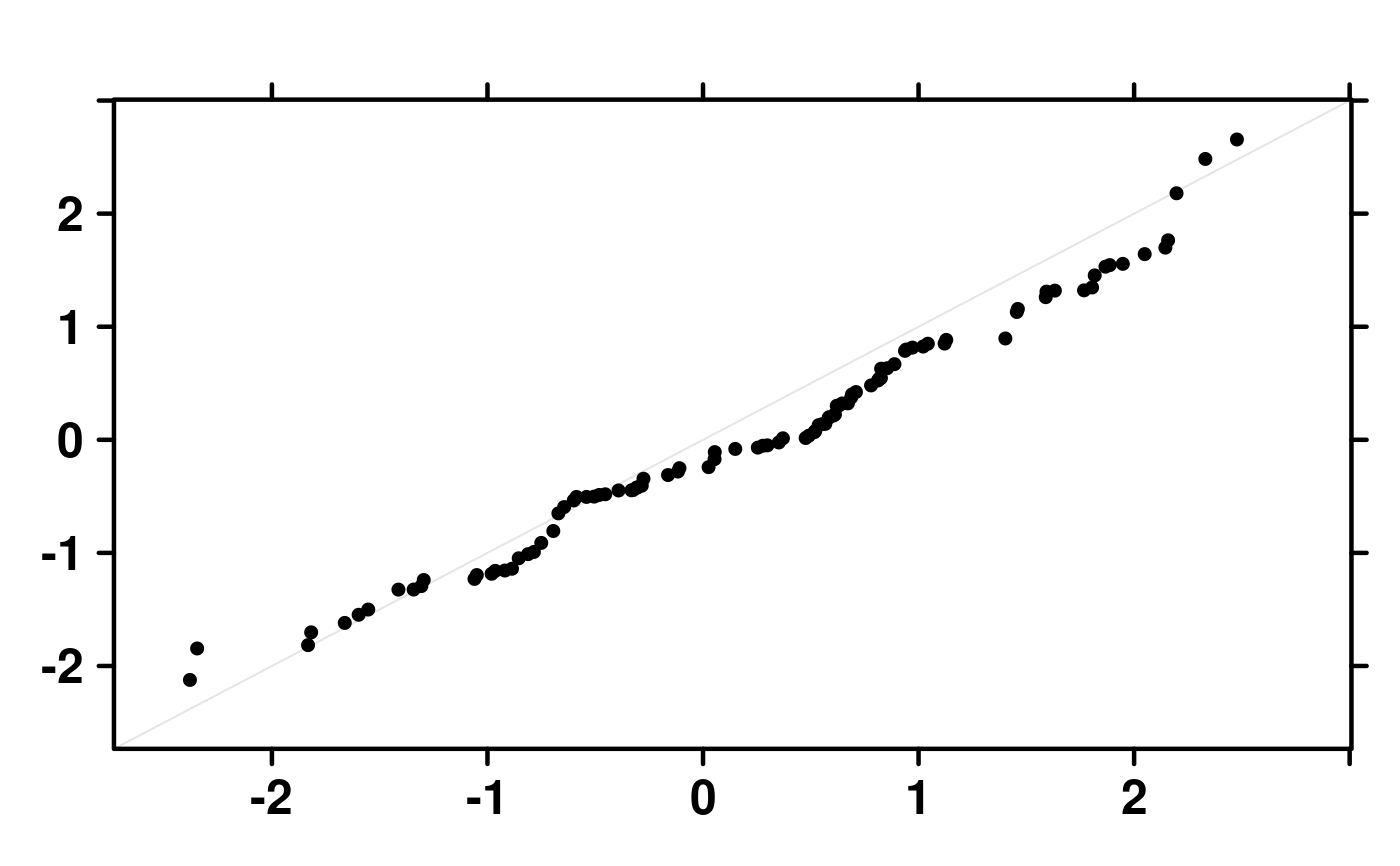 # Minimal Input
create.qqplot.comparison(
# filename = tempfile(pattern = 'QQcomparison_Minimal_Input', fileext = '.tiff'),
x = list(microarray[1:500,2], microarray[1:500,2]),
main = 'Minimal input',
description = 'QQplot comparison created by BoutrosLab.plotting.general',
resolution = 50
);
# Minimal Input
create.qqplot.comparison(
# filename = tempfile(pattern = 'QQcomparison_Minimal_Input', fileext = '.tiff'),
x = list(microarray[1:500,2], microarray[1:500,2]),
main = 'Minimal input',
description = 'QQplot comparison created by BoutrosLab.plotting.general',
resolution = 50
);
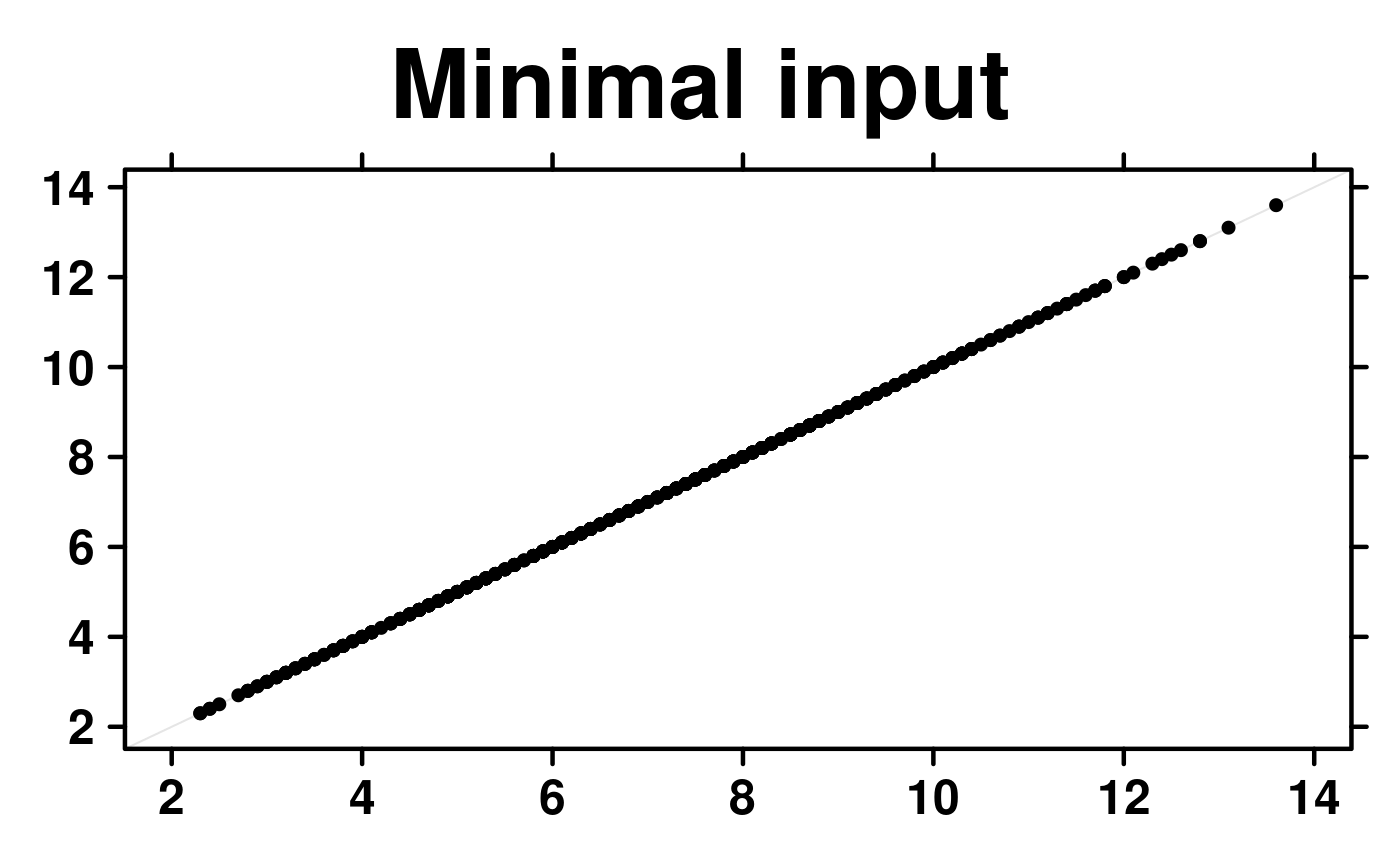 # Axes & Labels
create.qqplot.comparison(
# filename = tempfile(pattern = 'QQcomparison_Axes_Labels', fileext = '.tiff'),
x = list(microarray[1:500,2], microarray[1:500,2]),
main = 'Axes & labels',
# adding axes and labels
xlab.label = 'Sample 1',
ylab.label = 'Sample 2',
xlab.cex = 1.5,
ylab.cex = 1.5,
# adding grid for good measure
add.grid = TRUE,
description = 'QQplot comparison created by BoutrosLab.plotting.general',
resolution = 100
);
# Axes & Labels
create.qqplot.comparison(
# filename = tempfile(pattern = 'QQcomparison_Axes_Labels', fileext = '.tiff'),
x = list(microarray[1:500,2], microarray[1:500,2]),
main = 'Axes & labels',
# adding axes and labels
xlab.label = 'Sample 1',
ylab.label = 'Sample 2',
xlab.cex = 1.5,
ylab.cex = 1.5,
# adding grid for good measure
add.grid = TRUE,
description = 'QQplot comparison created by BoutrosLab.plotting.general',
resolution = 100
);
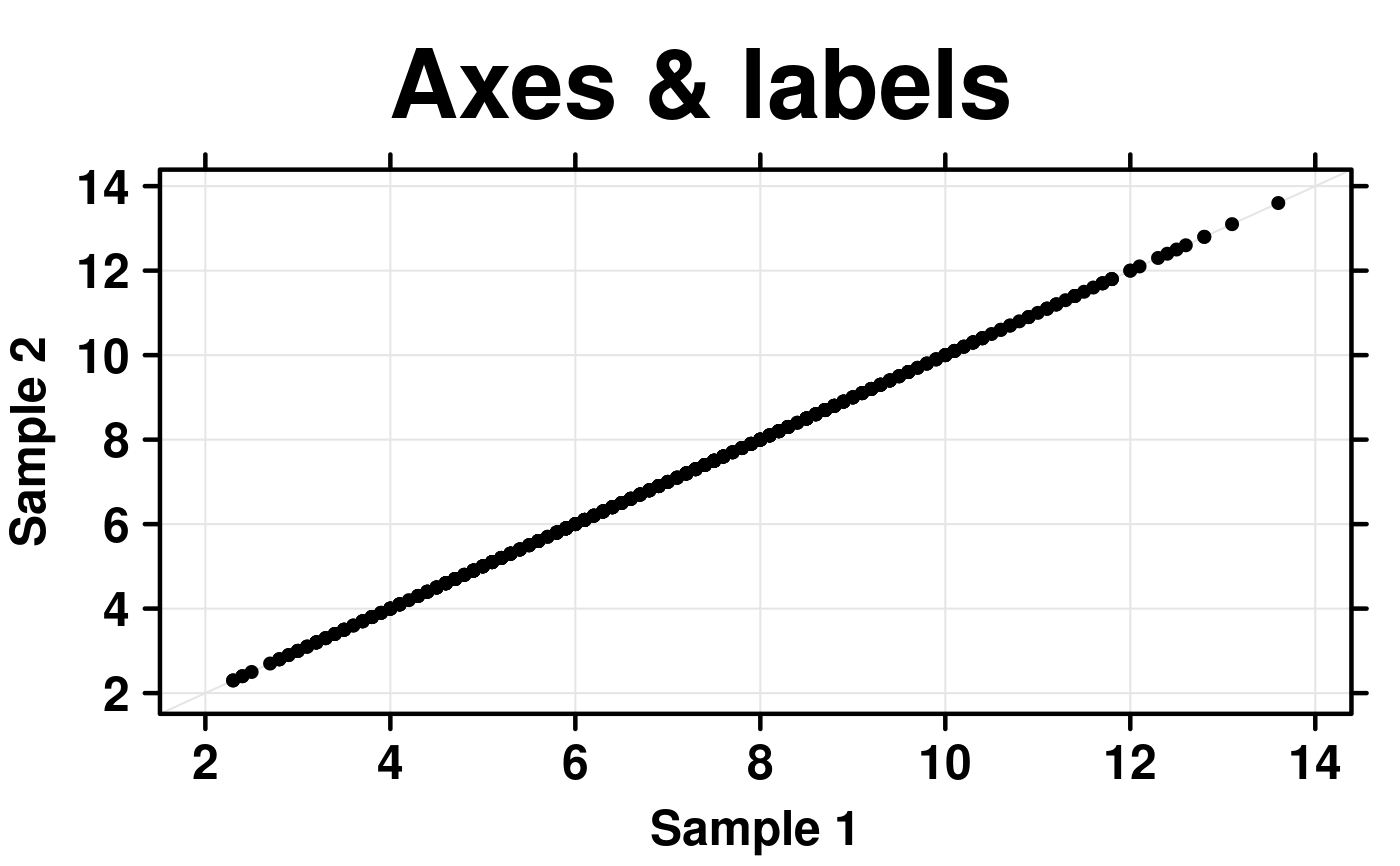 # Formula input
# 'Formula' format of data
chr.locations <- microarray$Chr[1:500];
chr.locations <- replace(chr.locations, which(chr.locations == 1), 'Chromosome 1');
chr.locations <- replace(chr.locations, which(chr.locations == 2), 'Chromosome 2');
qqplot.data <- data.frame(
sample = c(rep('Sample 1', 500), rep('Sample 2', 500)),
value = c(microarray[1:500,1], microarray[1:500,2]),
chr = chr.locations
);
create.qqplot.comparison(
# filename = tempfile(pattern = 'QQcomparison_Formula', fileext = '.tiff'),
# Using a different input method
x = sample ~ value,
data = qqplot.data,
main = 'Formula input',
xlab.label = 'Sample 1',
ylab.label = 'Sample 2',
xaxis.lab = seq(0, 15, 5),
yaxis.lab = seq(0, 15, 5),
xlimits = c(0, 17),
ylimits = c(0, 17),
xlab.cex = 1.5,
ylab.cex = 1.5,
add.grid = TRUE,
description = 'QQplot comparison created by BoutrosLab.plotting.general',
resolution = 200
);
# Formula input
# 'Formula' format of data
chr.locations <- microarray$Chr[1:500];
chr.locations <- replace(chr.locations, which(chr.locations == 1), 'Chromosome 1');
chr.locations <- replace(chr.locations, which(chr.locations == 2), 'Chromosome 2');
qqplot.data <- data.frame(
sample = c(rep('Sample 1', 500), rep('Sample 2', 500)),
value = c(microarray[1:500,1], microarray[1:500,2]),
chr = chr.locations
);
create.qqplot.comparison(
# filename = tempfile(pattern = 'QQcomparison_Formula', fileext = '.tiff'),
# Using a different input method
x = sample ~ value,
data = qqplot.data,
main = 'Formula input',
xlab.label = 'Sample 1',
ylab.label = 'Sample 2',
xaxis.lab = seq(0, 15, 5),
yaxis.lab = seq(0, 15, 5),
xlimits = c(0, 17),
ylimits = c(0, 17),
xlab.cex = 1.5,
ylab.cex = 1.5,
add.grid = TRUE,
description = 'QQplot comparison created by BoutrosLab.plotting.general',
resolution = 200
);
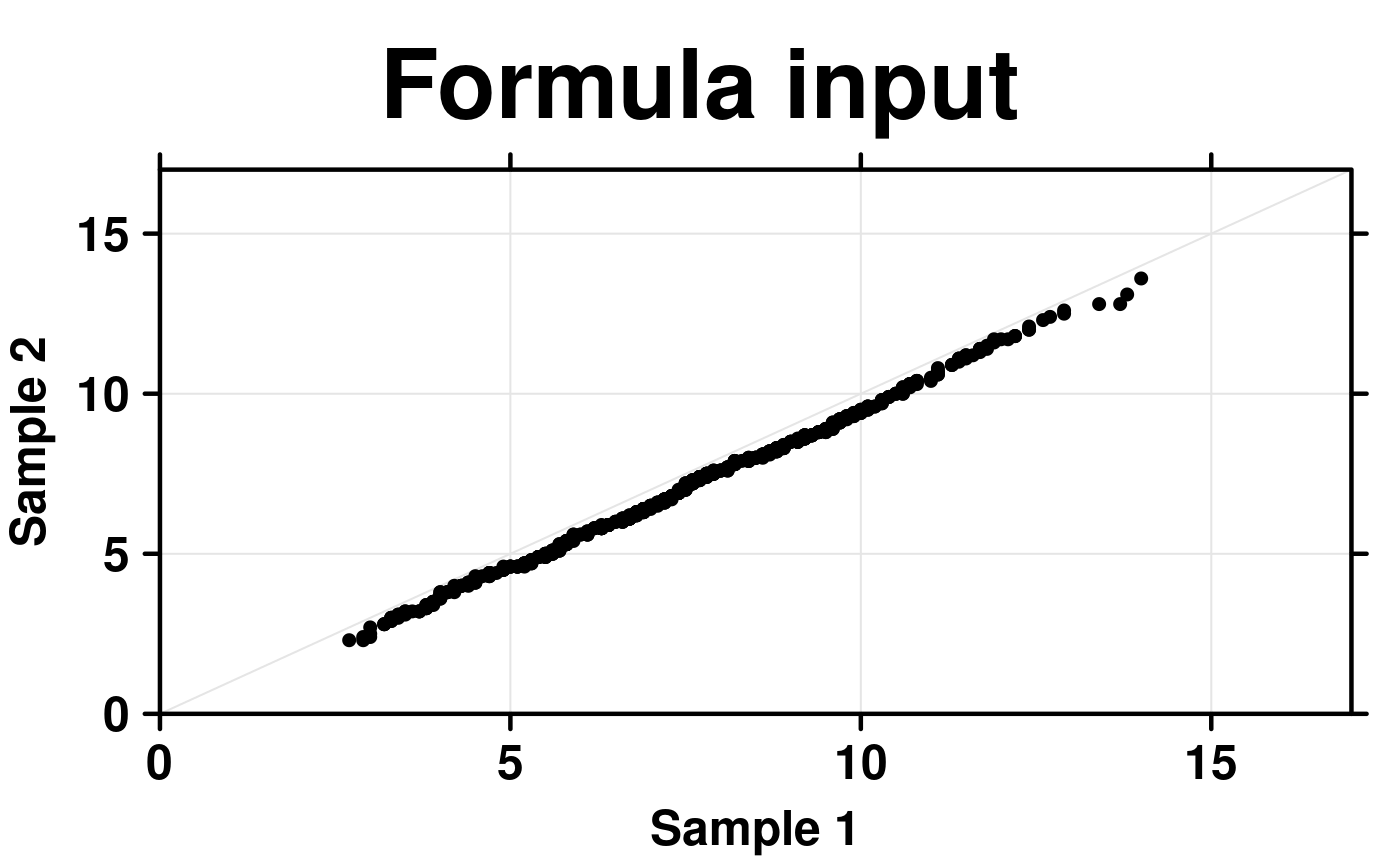 # \donttest{
# Groups & Legend
create.qqplot.comparison(
# filename = tempfile(pattern = 'QQcomparison_Groups_Legend', fileext = '.tiff'),
x = sample ~ value,
data = qqplot.data,
# Using fake grouping for the sake of illustration
groups = qqplot.data$chr,
# Set colours to differente the gruops
col = default.colours(3),
# Setting different plotting characters
pch = c(15, 16),
main = 'Groups & legend',
xlab.label = 'Sample 1',
ylab.label = 'Sample 2',
xlab.cex = 1.5,
ylab.cex = 1.5,
add.grid = TRUE,
# Adding legend to explain groups
key = list(
text = list(
lab = c('1','2'),
cex = 1.5,
col = 'black'
),
points = list(
pch = c(15, 16),
col = default.colours(2),
cex = 1
),
x = 0.04,
y = 0.95,
padding.text = 2
),
description = 'QQplot comparison created by BoutrosLab.plotting.general',
resolution = 200
);
# \donttest{
# Groups & Legend
create.qqplot.comparison(
# filename = tempfile(pattern = 'QQcomparison_Groups_Legend', fileext = '.tiff'),
x = sample ~ value,
data = qqplot.data,
# Using fake grouping for the sake of illustration
groups = qqplot.data$chr,
# Set colours to differente the gruops
col = default.colours(3),
# Setting different plotting characters
pch = c(15, 16),
main = 'Groups & legend',
xlab.label = 'Sample 1',
ylab.label = 'Sample 2',
xlab.cex = 1.5,
ylab.cex = 1.5,
add.grid = TRUE,
# Adding legend to explain groups
key = list(
text = list(
lab = c('1','2'),
cex = 1.5,
col = 'black'
),
points = list(
pch = c(15, 16),
col = default.colours(2),
cex = 1
),
x = 0.04,
y = 0.95,
padding.text = 2
),
description = 'QQplot comparison created by BoutrosLab.plotting.general',
resolution = 200
);
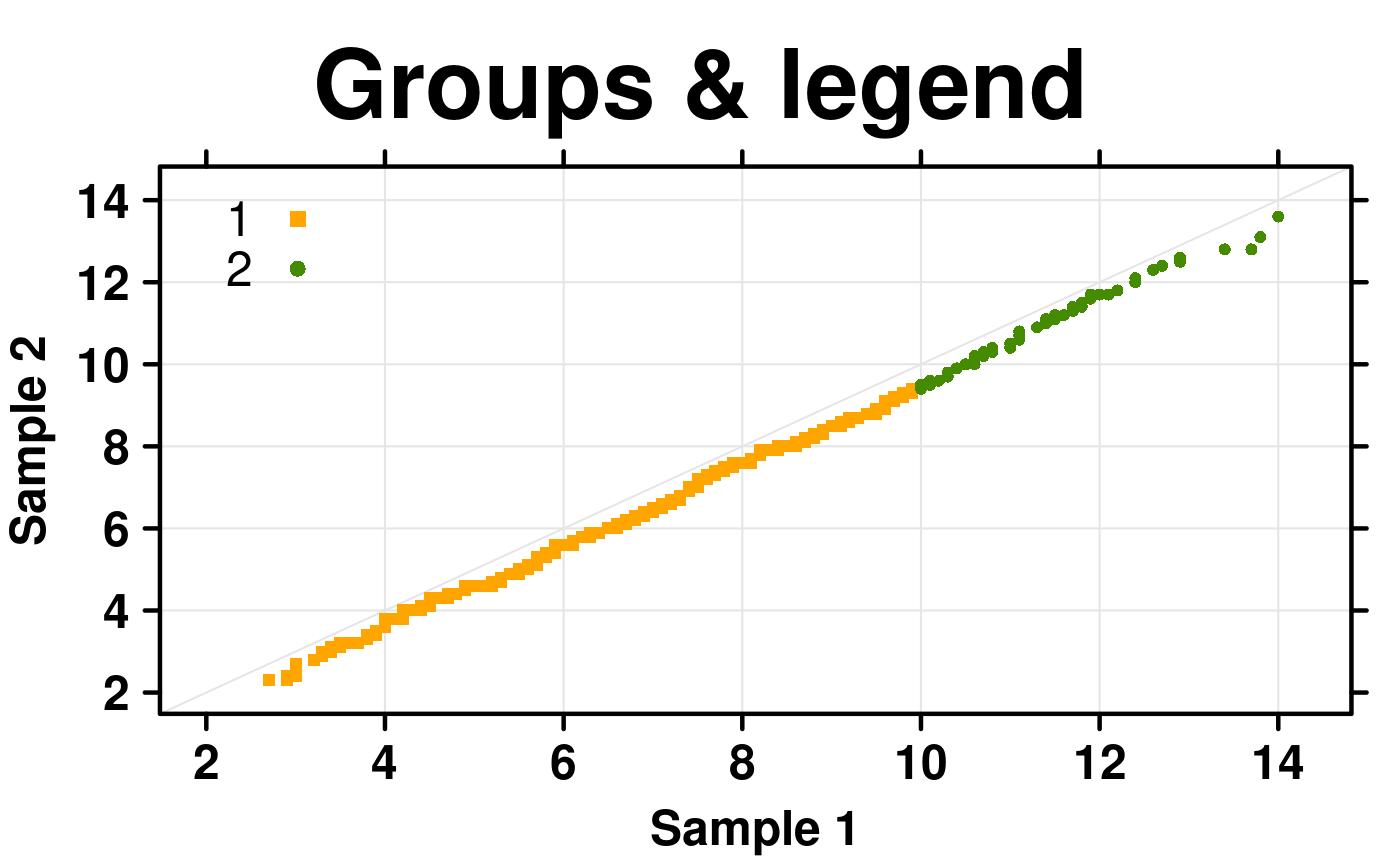 # Multiple qq plots
create.qqplot.comparison(
# filename = tempfile(pattern = 'QQcomparison_Multiple', fileext = '.tiff'),
x = sample ~ value | chr,
data = qqplot.data,
main = 'Multiple plots',
xlab.label = 'Sample 1',
ylab.label = 'Sample 2',
xlab.cex = 1.5,
ylab.cex = 1.5,
add.grid = TRUE,
description = 'QQplot comparison created by BoutrosLab.plotting.general',
resolution = 200
);
# Multiple qq plots
create.qqplot.comparison(
# filename = tempfile(pattern = 'QQcomparison_Multiple', fileext = '.tiff'),
x = sample ~ value | chr,
data = qqplot.data,
main = 'Multiple plots',
xlab.label = 'Sample 1',
ylab.label = 'Sample 2',
xlab.cex = 1.5,
ylab.cex = 1.5,
add.grid = TRUE,
description = 'QQplot comparison created by BoutrosLab.plotting.general',
resolution = 200
);
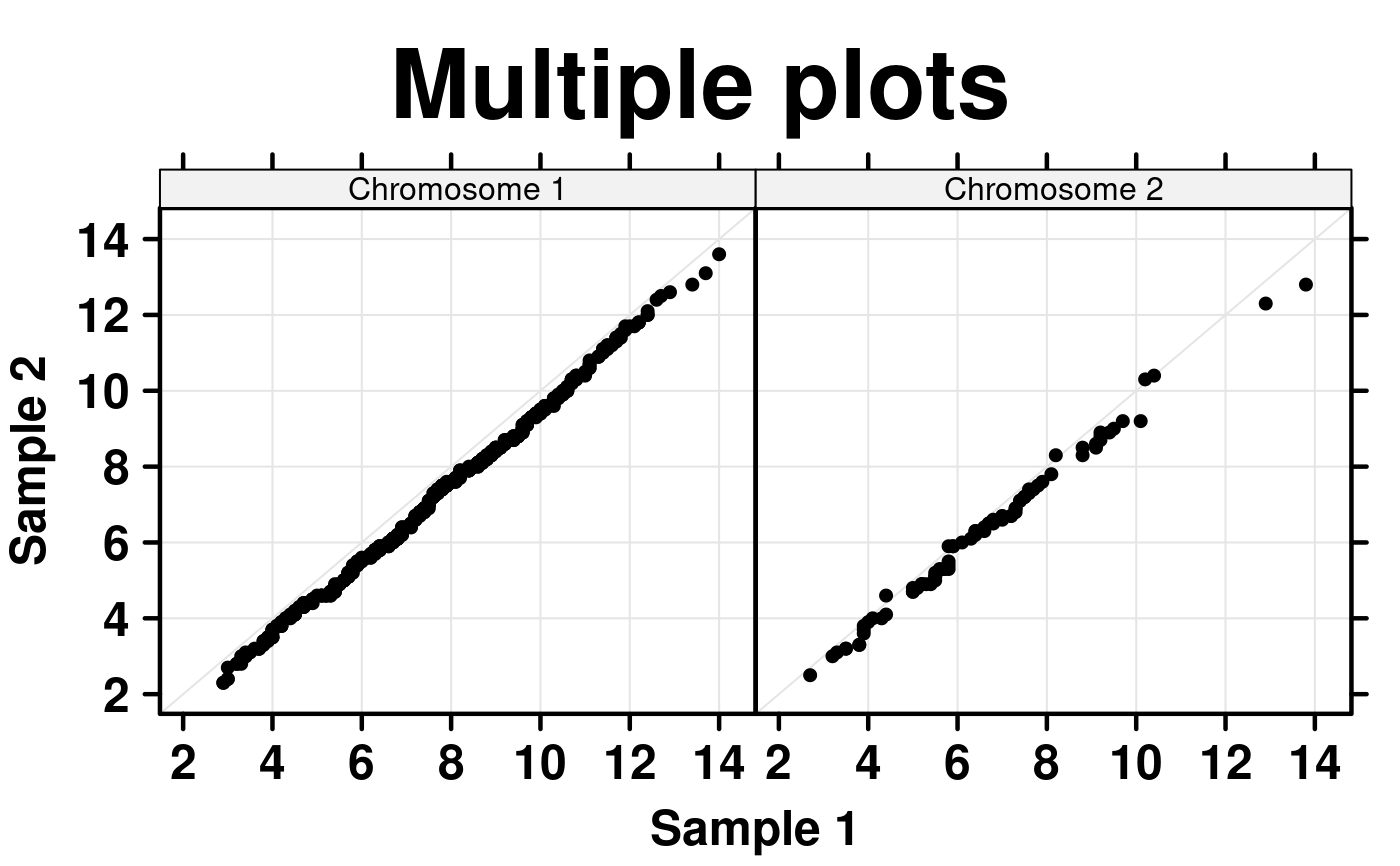 # Nature style
create.qqplot.comparison(
# filename = tempfile(pattern = 'QQcomparison_Nature_style', fileext = '.tiff'),
x = sample ~ value,
data = qqplot.data,
main = 'Nature style',
xlab.cex = 1.5,
ylab.cex = 1.5,
add.grid = TRUE,
# set style to Nature
style = 'Nature',
# demonstrating how to italicize character variables
ylab.label = expression(paste('italicized ', italic('a'))),
# demonstrating how to create en-dashes
xlab.label = expression(paste('en dashs: 1','\u2013', '10'^'\u2013', ''^3)),
description = 'QQplot comparison created by BoutrosLab.plotting.general',
resolution = 200
);
#> Warning: Setting resolution to 1200 dpi.
#> Warning: Nature also requires italicized single-letter variables and en-dashes
#> for ranges and negatives. See example in documentation for how to do this.
#> Warning: Avoid red-green colour schemes, create TIFF files, do not outline the figure or legend.
# Nature style
create.qqplot.comparison(
# filename = tempfile(pattern = 'QQcomparison_Nature_style', fileext = '.tiff'),
x = sample ~ value,
data = qqplot.data,
main = 'Nature style',
xlab.cex = 1.5,
ylab.cex = 1.5,
add.grid = TRUE,
# set style to Nature
style = 'Nature',
# demonstrating how to italicize character variables
ylab.label = expression(paste('italicized ', italic('a'))),
# demonstrating how to create en-dashes
xlab.label = expression(paste('en dashs: 1','\u2013', '10'^'\u2013', ''^3)),
description = 'QQplot comparison created by BoutrosLab.plotting.general',
resolution = 200
);
#> Warning: Setting resolution to 1200 dpi.
#> Warning: Nature also requires italicized single-letter variables and en-dashes
#> for ranges and negatives. See example in documentation for how to do this.
#> Warning: Avoid red-green colour schemes, create TIFF files, do not outline the figure or legend.
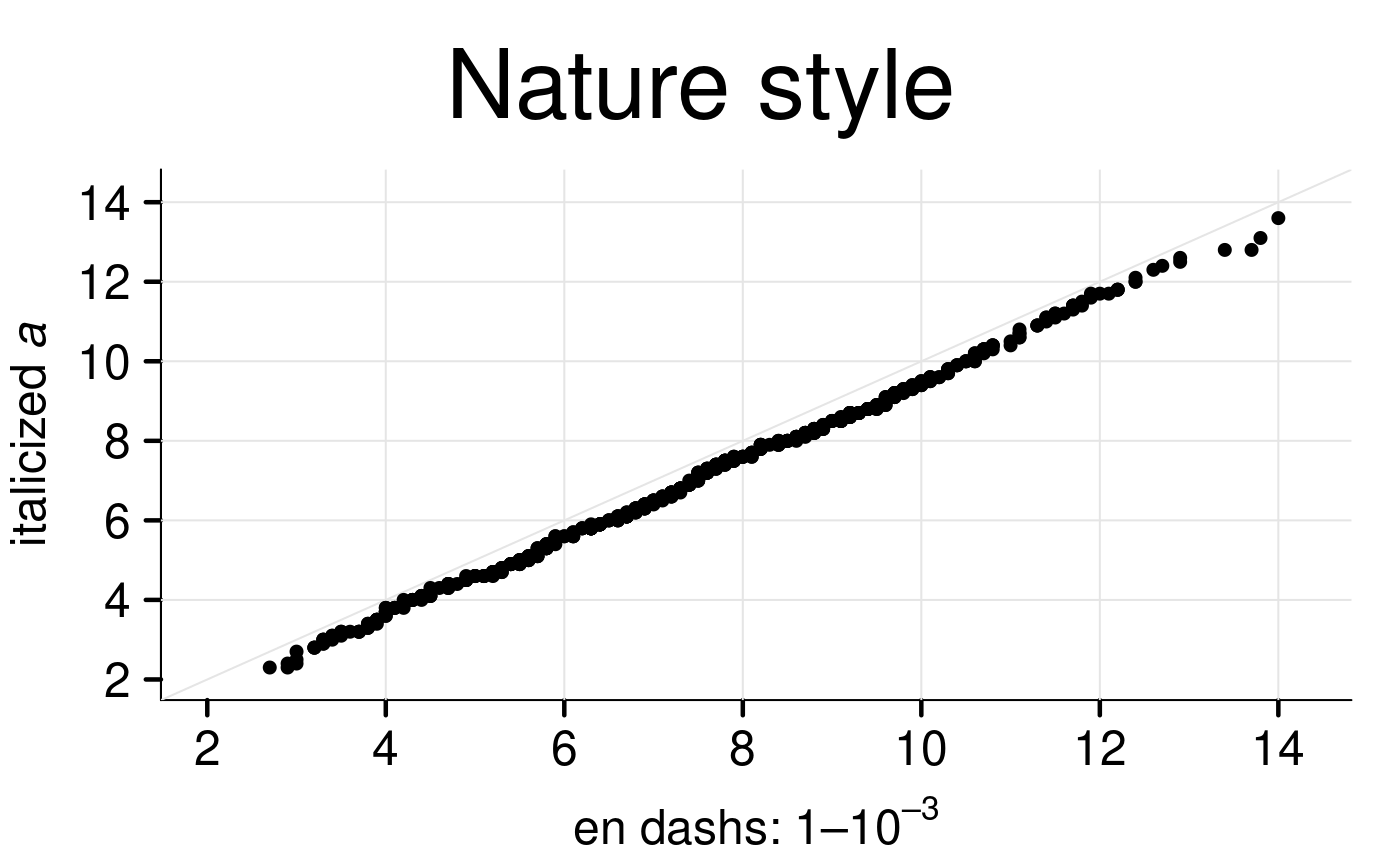 # }
# }